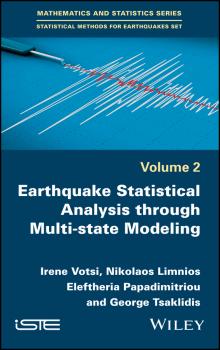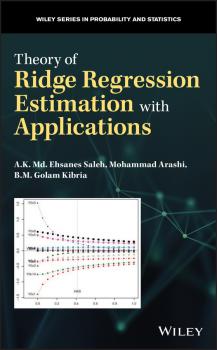ТОП просматриваемых книг сайта:
Математика
Различные книги в жанре Математика, доступные для чтения и скачиванияАннотация
An in-depth description of the state-of-the-art of 3D shape analysis techniques and their applications This book discusses the different topics that come under the title of «3D shape analysis». It covers the theoretical foundations and the major solutions that have been presented in the literature. It also establishes links between solutions proposed by different communities that studied 3D shape, such as mathematics and statistics, medical imaging, computer vision, and computer graphics. The first part of 3D Shape Analysis: Fundamentals, Theory, and Applications provides a review of the background concepts such as methods for the acquisition and representation of 3D geometries, and the fundamentals of geometry and topology. It specifically covers stereo matching, structured light, and intrinsic vs. extrinsic properties of shape. Parts 2 and 3 present a range of mathematical and algorithmic tools (which are used for e.g., global descriptors, keypoint detectors, local feature descriptors, and algorithms) that are commonly used for the detection, registration, recognition, classification, and retrieval of 3D objects. Both also place strong emphasis on recent techniques motivated by the spread of commodity devices for 3D acquisition. Part 4 demonstrates the use of these techniques in a selection of 3D shape analysis applications. It covers 3D face recognition, object recognition in 3D scenes, and 3D shape retrieval. It also discusses examples of semantic applications and cross domain 3D retrieval, i.e. how to retrieve 3D models using various types of modalities, e.g. sketches and/or images. The book concludes with a summary of the main ideas and discussions of the future trends. 3D Shape Analysis: Fundamentals, Theory, and Applications is an excellent reference for graduate students, researchers, and professionals in different fields of mathematics, computer science, and engineering. It is also ideal for courses in computer vision and computer graphics, as well as for those seeking 3D industrial/commercial solutions.
Аннотация
Earthquake occurrence modeling is a rapidly developing research area. This book deals with its critical issues, ranging from theoretical advances to practical applications. The introductory chapter outlines state-of-the-art earthquake modeling approaches based on stochastic models. Chapter 2 presents seismogenesis in association with the evolving stress field. Chapters 3 to 5 present earthquake occurrence modeling by means of hidden (semi-)Markov models and discuss associated characteristic measures and relative estimation aspects. Further comparisons, the most important results and our concluding remarks are provided in Chapters 6 and 7.
Аннотация
A guide to the systematic analytical results for ridge, LASSO, preliminary test, and Stein-type estimators with applications Theory of Ridge Regression Estimation with Applications offers a comprehensive guide to the theory and methods of estimation. Ridge regression and LASSO are at the center of all penalty estimators in a range of standard models that are used in many applied statistical analyses. Written by noted experts in the field, the book contains a thorough introduction to penalty and shrinkage estimation and explores the role that ridge, LASSO, and logistic regression play in the computer intensive area of neural network and big data analysis. Designed to be accessible, the book presents detailed coverage of the basic terminology related to various models such as the location and simple linear models, normal and rank theory-based ridge, LASSO, preliminary test and Stein-type estimators.The authors also include problem sets to enhance learning. This book is a volume in the Wiley Series in Probability and Statistics series that provides essential and invaluable reading for all statisticians. This important resource: Offers theoretical coverage and computer-intensive applications of the procedures presented Contains solutions and alternate methods for prediction accuracy and selecting model procedures Presents the first book to focus on ridge regression and unifies past research with current methodology Uses R throughout the text and includes a companion website containing convenient data sets Written for graduate students, practitioners, and researchers in various fields of science, Theory of Ridge Regression Estimation with Applications is an authoritative guide to the theory and methodology of statistical estimation.
Аннотация
An essential guide on high dimensional multivariate time series including all the latest topics from one of the leading experts in the field Following the highly successful and much lauded book, Time Series Analysis—Univariate and Multivariate Methods, this new work by William W.S. Wei focuses on high dimensional multivariate time series, and is illustrated with numerous high dimensional empirical time series. Beginning with the fundamentalconcepts and issues of multivariate time series analysis,this book covers many topics that are not found in general multivariate time series books. Some of these are repeated measurements, space-time series modelling, and dimension reduction. The book also looks at vector time series models, multivariate time series regression models, and principle component analysis of multivariate time series. Additionally, it provides readers with information on factor analysis of multivariate time series, multivariate GARCH models, and multivariate spectral analysis of time series. With the development of computers and the internet, we have increased potential for data exploration. In the next few years, dimension will become a more serious problem. Multivariate Time Series Analysis and its Applications provides some initial solutions, which may encourage the development of related software needed for the high dimensional multivariate time series analysis. Written by bestselling author and leading expert in the field Covers topics not yet explored in current multivariate books Features classroom tested material Written specifically for time series courses Multivariate Time Series Analysis and its Applications is designed for an advanced time series analysis course. It is a must-have for anyone studying time series analysis and is also relevant for students in economics, biostatistics, and engineering.
Аннотация
Volume II provides an advanced approach to the extended gibonacci family, which includes Fibonacci, Lucas, Pell, Pell-Lucas, Jacobsthal, Jacobsthal-Lucas, Vieta, Vieta-Lucas, and Chebyshev polynomials of both kinds. This volume offers a uniquely unified, extensive, and historical approach that will appeal to both students and professional mathematicians. As in Volume I, Volume II focuses on problem-solving techniques such as pattern recognition; conjecturing; proof-techniques, and applications. It offers a wealth of delightful opportunities to explore and experiment, as well as plentiful material for group discussions, seminars, presentations, and collaboration. In addition, the material covered in this book promotes intellectual curiosity, creativity, and ingenuity. Volume II features: A wealth of examples, applications, and exercises of varying degrees of difficulty and sophistication. Numerous combinatorial and graph-theoretic proofs and techniques. A uniquely thorough discussion of gibonacci subfamilies, and the fascinating relationships that link them. Examples of the beauty, power, and ubiquity of the extended gibonacci family. An introduction to tribonacci polynomials and numbers, and their combinatorial and graph-theoretic models. Abbreviated solutions provided for all odd-numbered exercises. Extensive references for further study. This volume will be a valuable resource for upper-level undergraduates and graduate students, as well as for independent study projects, undergraduate and graduate theses. It is the most comprehensive work available, a welcome addition for gibonacci enthusiasts in computer science, electrical engineering, and physics, as well as for creative and curious amateurs.
Аннотация
Introduces the latest developments in forecasting in advanced quantitative data analysis This book presents advanced univariate multiple regressions, which can directly be used to forecast their dependent variables, evaluate their in-sample forecast values, and compute forecast values beyond the sample period. Various alternative multiple regressions models are presented based on a single time series, bivariate, and triple time-series, which are developed by taking into account specific growth patterns of each dependent variables, starting with the simplest model up to the most advanced model. Graphs of the observed scores and the forecast evaluation of each of the models are offered to show the worst and the best forecast models among each set of the models of a specific independent variable. Advanced Time Series Data Analysis: Forecasting Using EViews provides readers with a number of modern, advanced forecast models not featured in any other book. They include various interaction models, models with alternative trends (including the models with heterogeneous trends), and complete heterogeneous models for monthly time series, quarterly time series, and annually time series. Each of the models can be applied by all quantitative researchers. Presents models that are all classroom tested Contains real-life data samples Contains over 350 equation specifications of various time series models Contains over 200 illustrative examples with special notes and comments Applicable for time series data of all quantitative studies Advanced Time Series Data Analysis: Forecasting Using EViews will appeal to researchers and practitioners in forecasting models, as well as those studying quantitative data analysis. It is suitable for those wishing to obtain a better knowledge and understanding on forecasting, specifically the uncertainty of forecast values.
Аннотация
A new edition of this popular text on robust statistics, thoroughly updated to include new and improved methods and focus on implementation of methodology using the increasingly popular open-source software R. Classical statistics fail to cope well with outliers associated with deviations from standard distributions. Robust statistical methods take into account these deviations when estimating the parameters of parametric models, thus increasing the reliability of fitted models and associated inference. This new, second edition of Robust Statistics: Theory and Methods (with R) presents a broad coverage of the theory of robust statistics that is integrated with computing methods and applications. Updated to include important new research results of the last decade and focus on the use of the popular software package R, it features in-depth coverage of the key methodology, including regression, multivariate analysis, and time series modeling. The book is illustrated throughout by a range of examples and applications that are supported by a companion website featuring data sets and R code that allow the reader to reproduce the examples given in the book. Unlike other books on the market, Robust Statistics: Theory and Methods (with R) offers the most comprehensive, definitive, and up-to-date treatment of the subject. It features chapters on estimating location and scale; measuring robustness; linear regression with fixed and with random predictors; multivariate analysis; generalized linear models; time series; numerical algorithms; and asymptotic theory of M-estimates. Explains both the use and theoretical justification of robust methods Guides readers in selecting and using the most appropriate robust methods for their problems Features computational algorithms for the core methods Robust statistics research results of the last decade included in this 2nd edition include: fast deterministic robust regression, finite-sample robustness, robust regularized regression, robust location and scatter estimation with missing data, robust estimation with independent outliers in variables, and robust mixed linear models. Robust Statistics aims to stimulate the use of robust methods as a powerful tool to increase the reliability and accuracy of statistical modelling and data analysis. It is an ideal resource for researchers, practitioners, and graduate students in statistics, engineering, computer science, and physical and social sciences.
Аннотация
Анализ окружающего Мира, его связи и закономерности, делятся на две части – Идеальный Мир и Мир Реальности. Сравнение происходит с помощью моделей: идеальных и реальных колебаний. Результаты позволяют расширить наше понимание как математических законов, так и законов Мира в целом.
Математика для безнадежных гуманитариев. Для тех, кто учил языки, литературу и прочую лирику - Нелли Литвак
Безнадёжный гуманитарийАннотация
Если вы убеждены в существовании особых математических способностей или считаете слово «гуманитарий» оскорблением, вы попали в ловушку устаревших стереотипов. Профессор математики, лауреат премии «Просветитель» Нелли Литвак и креативный продюсер Алла Кечеджан не только докажут вам, что математика доступна абсолютно всем, но и научат смотреть на мир через призму этой науки. Если вы считаете себя гуманитарием, вы узнаете, какие математические законы связывают паркет на полу комнаты с вращением спутника и биением сердца. Если вы считаете себя математиком, вы узнаете, как избежать систематической ошибки выжившего, а уже известные положения науки предстанут перед вами в новом свете.
Математика в комиксах. Зачем нужна математика, основные теории, системы и многое другое… - Борин Ван Лоон
Наука в комиксахАннотация
Зачем нужна математика? Что такое особенные числа? Как открыли тригонометрию? Как появилась европейская математика? Неопределенность и вероятность. На эти и другие вопросы ответит книга «Математика в комиксах». Перед вами уникальная история математики от Древнего мира до современности, прогресс и парадоксы этой удивительной науки.










